14_-_Circulation_and_Gas_exchange
Lecture Notes:
Everything needs to do circulation and gas exchange
Simple unicellular organisms can do this passively with no specialized organ systems because of diffusion. Just dump stuff out and intake stuff via diffusion because there is only one layers of cells separating the organism form it’s environment.
More complex organisms need specialized organs and tissues to do gas exchange
Closed vs Open circulatory systems
Feature | Closed Circulatory System | Open Circulatory System |
|---|---|---|
Blood Containment | Blood remains contained within vessels | Hemolymph flows freely around organs |
Transport Medium | Blood transports oxygen, nutrients, and waste | Hemolymph transports nutrients and waste but not oxygen |
Circulation | Blood circulates in a closed loop | Hemolymph bathes organs directly. Allows interstitial fluid to mix freely with vascular fluid |
Pump Mechanism | Uses a heart to pump blood through vessels | Heart pumps hemolymph through arteries into sinuses |
Efficiency | More efficient for larger organisms; facilitates gas exchange and nutrient transport | Less efficient for larger organisms, suitable for smaller animals |
Examples | Humans, reptiles, amphibians, fish | Arthropods (insects, crustaceans) |
Open circulatory system of arthropods
Hemolymph bathes organs, fluid is filtered, and shot back up to the brain by the dorsal aorta and then it flows back
The dorsal aorta contains chambers, alary muscles flex to pull the vessels open, fluid flows in through ostea (holes), alary muscles relax fluid shoots up through the vessel because the ostea close up.
Hemolymph is not contained within vessels; it flows freely around organs.
The heart is a long, tube-like structure that contracts to pump hemolymph.
Nutrients and waste are transported by hemolymph but it does not transport oxygen like vertebrate blood.
Muscle contractions assist in moving hemolymph throughout the body.
This system is efficient for the smaller body size of arthropods, matching their metabolic needs.
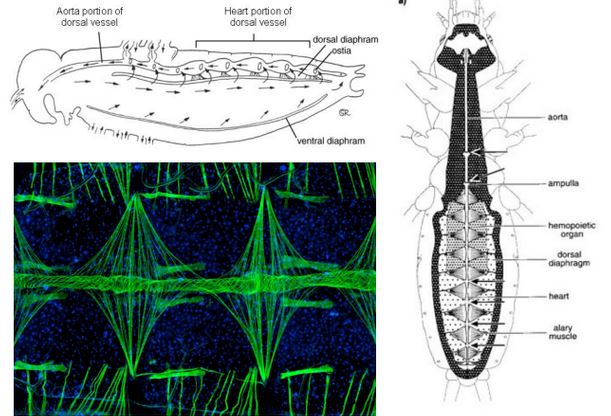
Arthropods have a trache system that sends gas straight to body systems rather than dissolving it in fluids because it’s more efficient
Humans don’t have this because we are too big, we would have to be constantly moving, and we’d be collapsing these holes when we lie down.
Insects were larger in the past because there was more oxygen back then.
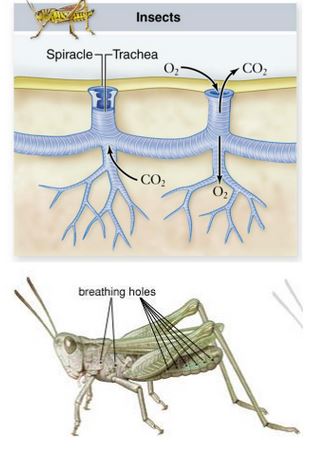
Closed circulatory system of humans reptiles, amphibians, fish:
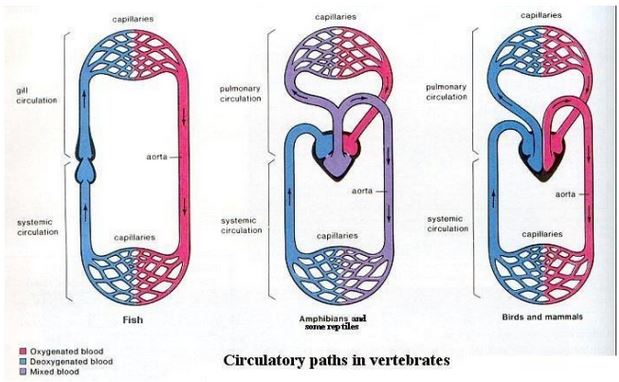
Feature | Fish | Mammals | Birds |
|---|---|---|---|
Blood Circulation | heart → gills → body Counter current exchange | heart → lungs → body Cocurrent exchange | heart → air sacs → lungs → body Unidirectional air flow |
Oxygen Acquisition | Gills | Lungs | Lungs with air sacs |
Heart Structure | Two-chambered heart (1 atrium, 1 ventricle) | Four-chambered heart (2 atria, 2 ventricles) | Four-chambered heart (similar structure to mammals) |
Efficiency of Gas Exchange | Lower efficiency due to single circuit | Higher efficiency due to double circuit | Higher efficiency due to cross-current exchange system |
Blood stays in vessels
Fluid in the body sometimes leaks out 2/3 of that fluid is intracellular (cytoplasm), 1/3 is intercellular (plasma or lymph fluid).
When the plasma exits the bloodstream, it’s called interstitial fluid, it gets reabsorbed by the capillary bed.
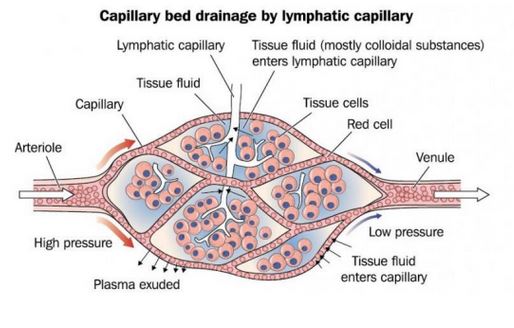
Fish closed circulatory system:
Gill filaments allows for maximized surface area and counter current exchange to maintain concentration gradient and efficient gas exchange throughout the flow.

Human closed circulatory system:
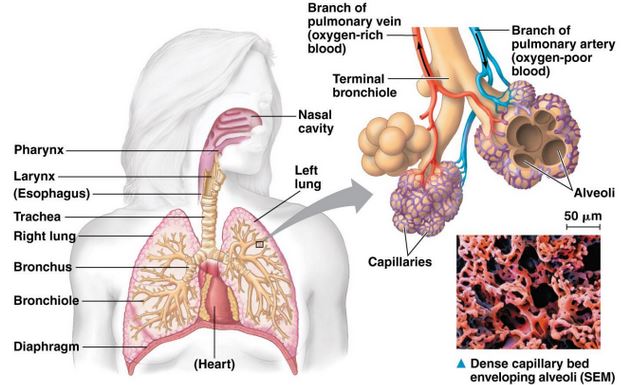
Boyle’s law: Pressure and volume are inversely proportional to each other.
Deadspace volume: The portion of the respiratory system where gas exchange does not occur. This volume impacts overall respiratory efficiency, as ventilated air in these spaces does not contribute to oxygen uptake or carbon dioxide removal during respiration.
Birds closed circulatory system:
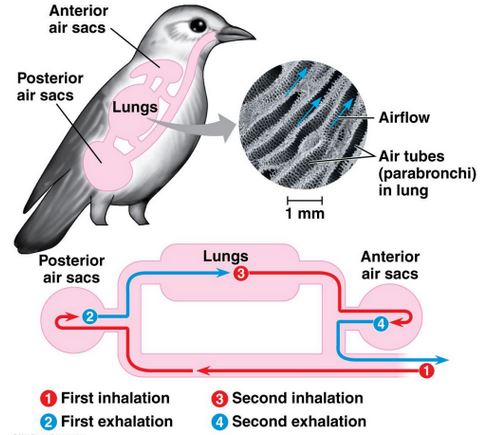
Birds have unidirectional airflow, leading to no deadspace volume
The air sacs hold air temporarily
Cross current air flow: air flows perpendicular to the blood flow in the lungs. This arrangement enhances the efficiency of gas exchange by maintaining a concentration gradient that allows continuous oxygen uptake and carbon dioxide removal.
When we are exhaling, no gas exchange is occurring, when birds are exhaling, gas exchange is occurring.
BUG questions
How do unicellular organisms differ from multicellular organisms with regards to gas, nutrient, and waste exchange?
Unicellular: Easier to do gas exchange bc they are only a few layers thick. Direct interaction w environment due to small size.
Multicellular: Lengthier process. Not all parts inter fuse directly w outside environment. Solution: Specific systems for those processes.
Gas Exchange:
Unicellular organisms use diffusion for oxygen intake and carbon dioxide release.
Multicellular organisms have lungs or gills to enhance gas exchange and a circulatory system to distribute gases.
Nutrient Exchange:
Nutrients in unicellular organisms enter directly through the cell membrane from the environment.
Multicellular organisms use a digestive system to break down food, with the circulatory system transporting nutrients to cells.
Waste Exchange:
Unicellular organisms expel waste directly into the environment through the cell membrane.
Multicellular organisms utilize specialized organs (like kidneys) to collect and excrete wastes through their circulatory system.
Why is the gastrovascular cavity sufficient for gas, nutrient, and waste exchange in cnidaria but would not work for something like a fish?
The gastrovascular cavity in cnidaria is:
A multipurpose organ for gas, nutrient, and waste exchange.
Highly branched, providing a large surface area for diffusion.
Lined with a single layer of cells, allowing efficient substance exchange.
Adequate for small and simple organisms due to diffusion.
In contrast, fish have:
A complex body structure requiring a specialized circulatory system.
Gills for extracting oxygen from water.
A circulatory system to distribute oxygenated blood throughout the body.
The gastrovascular cavity would be insufficient for larger sizes due to:
Limitations of diffusion over longer distances.
Need for faster nutrient and gas transport.
How does the hemolymph in insects differ from our blood?
Hemolymph in insects is the equivalent of blood in vertebrates but differs significantly in structure and function.
Hemolymph is not contained within vessels; it flows freely in the hemocoel (body cavity). Humans have a closed system
It acts as a transport medium for nutrients, waste, and hormones but does not transport oxygen like blood does in vertebrates.
Hemolymph is responsible for delivering nutrients and removing waste products from cells.
It also plays a role in the immune response and maintaining hydrostatic pressure in insects.
Insects do not have red blood cells; instead, hemolymph contains a lighter-colored fluid with various cells floating in it, including those for immune function.
Explain how hemolymph circulates through the insect in the open circulatory system.
Hemolymph circulates through the insect in an open circulatory system as follows:
The heart is a long, tube-like structure (dorsal vessel) that contracts to pump hemolymph into the sinuses that surround organs or hemocoel (body cavity).
Hemolymph is pushed out of the heart into arteries that open into the hemocoel, bathing the organs and tissues.
The open nature of the circulatory system allows hemolymph to flow freely around the organs, providing them with nutrients and oxygen (though oxygen is primarily delivered through tracheae).
After circulating, hemolymph collects in sinuses, which are spaces within the hemocoel, before draining back to the heart through openings called ostia.
The ostia have valves that close during heart contraction to prevent backflow, allowing for a continuous circulation cycle.
Hemoplymph goes back to the heart
Muscle (alary) action drives the forward movement of hemolymph.
This system facilitates the distribution of nutrients and waste removal throughout the insect's body without the need for a closed system.
What role does the lymph system play with regards to fluids in the capillary bed?
The lymphatic system plays a crucial role in maintaining fluid balance in the capillary bed. It helps to:
Collect Excess Fluid and maintaining fluid balance: The capillaries are permeable, allowing some fluid to leak into interstitial spaces. The lymphatic system collects this excess fluid, preventing edema (swelling) in tissues.
Return to Circulatory System: Lymph vessels transport the collected interstitial fluid, now called lymph, back to the circulatory system, reintroducing it into the bloodstream at the thoracic duct or right lymphatic duct.
Transport Immune Cells: The lymphatic system also carries immune cells and proteins that can help defend against pathogens present in the fluid from tissues.
Filter Impurities: Lymph nodes filter the lymph to remove bacteria, waste, and other foreign materials before it re-enters the bloodstream.
What is a common misconception about how much blood is in the human body?
A common misconception is that most of the body’s fluid is blood. This is not true it’s mostly interstitial fluid and plasma.
Actual blood volume varies significantly based on factors like age, sex, body size, and health.
Adult humans generally have between 4.5 to 6 liters of blood, depending on these variables.
Many people are unaware that not all blood flows continuously in vessels; some blood is also present in tissues and extravascular spaces, which is not included in the typical volume measured within the circulatory system.
How can blood carry oxygen and other important nutrients to the cells if blood is defined as the stuff that stays in the blood vessels?
Blood carries everything, the stuff diffuses out the capillaries, blood doesn’t move
Blood is defined as the fluid contained within blood vessels, but it also plays a critical role in transporting oxygen and nutrients to cells.
Oxygen is primarily carried by red blood cells, which bind oxygen in the lungs and release it in tissues.
Nutrients from digested food enter the bloodstream through capillaries in the intestines.
Once in the blood, both oxygen and nutrients are distributed throughout the body via the circulatory system.
Various mechanisms also help cells uptake these substances from the blood, ensuring that essential materials reach where they are needed.
What is the difference between intracellular fluid and intercellular fluid?
Intracellular Fluid (ICF):
Found within the cells.
Contains a high concentration of potassium ions (K+) and low sodium ions (Na+).
Plays a critical role in maintaining cellular functions, metabolic processes, and homeostasis.
Intercellular Fluid (ISF):
Found in the spaces between cells and outside the cells.
Typically contains a higher concentration of sodium ions (Na+) and lower potassium ions (K+) compared to ICF.
Serves as a medium for the exchange of nutrients, waste, and signaling molecules between cells.
Interstitial fluid is a type of intercellular fluid.
Using your understanding of water potential, explain how fluid leaves and then re-enters the capillaries in the capillary bed.
Fluid movement in capillaries is influenced by water potential, which is the combination of solute potential and pressure potential.
At the arterial end of the capillary, the blood pressure is higher than the osmotic pressure, leading to fluid containing nutrients and oxygen being pushed out into the interstitial space. This outward movement occurs due to the high hydrostatic pressure in the capillaries.
As blood flows through the capillary bed, nutrients and oxygen diffused from the blood enter the interstitial fluid, where they can be utilized by surrounding cells. Blood also picks up waste from cells.
At the venous end of the capillary, blood pressure decreases while osmotic pressure (caused by higher solute concentration in the blood) remains relatively constant.
This results in fluid re-entering the capillary through osmosis, where the higher solute concentration in the blood draws water back into the capillary.
The lymphatic system aids in collecting any excess fluid that does not re-enter the capillaries, ensuring fluid balance in tissues.
How does blood flow in arteries differ from veins, as in where is it going and how is it moved there?
Blood flow in arteries is directed away from the heart, delivering oxygenated blood to various tissues throughout the body. In contrast, blood flow in veins is directed towards the heart, returning deoxygenated blood from the body back to the heart.
Arterial blood flow is facilitated by the high pressure generated by the heart's contractions and the elasticity of artery walls, which helps propel blood through the circulatory system.
Veins, on the other hand, are equipped with one-way valves that prevent backflow and rely on surrounding muscle contractions and movements, such as those from skeletal muscles, to assist in pushing blood back to the heart. Become larger as they get closer to the heart
Superior Vena Cava: Large vein that returns blood from head and arms to heart.
Anterior Vena Cava: Large vein that returns blood from legs and abdomen to the heart.
Aorta: Largest artery that exits the heart.
Capillaries: Thin for gas exchange, closest to cells and tissues

What problem do coma patients and crucifixion victims share with regards to blood flow?
Both coma patients and crucifixion victims experience poor blood circulation.
Impaired circulation can lead to tissue damage and organ failure.
In coma patients, reduced consciousness decreases the body's natural responses for maintaining circulation.
Crucifixion victims suffer from physical trauma and position, hindering blood flow and potentially causing asphyxiation and shock.
Compromised blood flow in both cases highlights the critical need for effective circulation to sustain life and bodily functions.
Blood and water exhibit countercurrent (flow in oppflow in the gills. How is this better for gas exchange than concurrent flow (flowing in the same direction).
Countercurrent flow is the movement of water and blood in opposite directions.
This mechanism increases efficiency of gas exchange compared to concurrent flow.
In countercurrent flow, oxygen concentration in the water is always higher than in the blood, promoting continuous oxygen diffusion into the blood.
This allows for a more effective removal of carbon dioxide from the blood into the water.
Concurrent flow results in a less efficient exchange as blood quickly reaches equilibrium with the oxygen in water, limiting oxygen uptake.
Overall, countercurrent flow maximizes the gradient for gas exchange, leading to better oxygen absorption and carbon dioxide release.

Why is the trachea system of insects more efficient than ours? That being said, why wouldn’t their trachea system work in us?
This system consists of a network of tubes (tracheae) that branch throughout the body, minimizing the distance oxygen needs to travel to reach cells.
Insects can also regulate airflow through spiracles, opening and closing to control gas exchange based on their needs.
Their small size and high surface area relative to volume enhance the efficacy of passive gas exchange.
However, this tracheal system wouldn't work in humans or larger animals because:
The reliance on diffusion for gas exchange is insufficient over longer distances found in larger body sizes.
Humans require a more complex system, like lungs, to accommodate higher oxygen demands and to ensure efficient gas transport through a circulatory system.
Insects also lack a blood-based oxygen transport system; instead, they rely solely on diffusion, which would not meet the metabolic requirements of larger organisms.
Why were insects, dinosaurs, and many other animals so much larger in the past?
Insects, dinosaurs, and many other animals were larger in the past due to several factors, including:
Higher atmospheric oxygen levels during certain geological periods, which supported greater body sizes by enhancing respiration. Oxygen = Growth
The lack of predation pressure allowed for larger sizes to evolve without the risk of being easily hunted.
The presence of abundant food sources facilitated the growth of large animals.
Evolutionary adaptations that favored larger body sizes for better thermoregulation and resource acquisition.
These factors combined helped create an environment conducive to the evolution of larger species.
What is Boyle’s Law, and how does it relate to how we inhale and exhale?
Boyle's Law states that at constant temperature, the pressure of a gas is inversely proportional to its volume. This means if the volume of a gas decreases, its pressure increases, and vice versa. P1V1 = P2V2
In terms of respiration:
During inhalation, the diaphragm contracts and expands the thoracic cavity, increasing the volume inside the lungs.
As the volume increases, the pressure inside the lungs drops below atmospheric pressure, causing air to flow in.
During exhalation, the diaphragm relaxes, reducing the volume of the thoracic cavity, which increases lung pressure. This higher pressure forces air out of the lungs.
Thus, Boyle's Law is fundamental in understanding how changes in lung volume during inhalation and exhalation affect air pressure, facilitating breathing.
Why is the avian respiratory system so much better than ours? Explain by describing features and air flow.
The avian respiratory system is significantly more efficient than the human respiratory system due to several key features and airflow processes:
Unidirectional (Non-tidal) Airflow: In birds, air flows in one direction through the respiratory system, which ensures a continuous exchange of gases.
Air Sacs: Birds possess air sacs that allow for the storage and movement of air during both inhalation and exhalation, providing a steady supply of fresh air to the lungs.
Cross-Current Exchange: The design of the avian lungs facilitates a cross-current exchange system, where fresh air and used air flow in perpendicular directions, maximizing oxygen uptake and carbon dioxide removal.
Efficient Gas Exchange Surface: The lungs of birds have a highly vascularized surface area that optimizes the exchange of gases, making it more effective than mammalian lungs.
High Metabolic Demand: These adaptations are particularly suited to meet the high metabolic demands of flight, allowing birds to maintain adequate oxygen levels even during intense activity.
These features collectively enhance the efficiency of the avian respiratory system, enabling better oxygen absorption and carbon dioxide expulsion compared to the mammalian system.